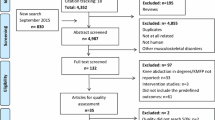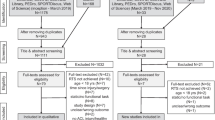Abstract
Purpose
This review compared knee muscle activity between ACL-deficient (ACLD) patients and healthy controls during gait, to find out whether the available electromyography (EMG) studies support Quadriceps (Q-ceps) inhibition or hamstring facilitation during gait in ACLD patients.
Method
A systematic review was conducted to retrieve the EMG studies of knee muscles during gait in ACLD patients. Cochrane library, PubMed, Medline, Ovid, CINAHL and Science Direct databases were searched entries from 1995 through October 2014 using the terms “anterior cruciate ligament” OR “ACL”, “electromyography” Or “EMG” “gait” Or “walking”. Articles that assessed subjects with ACL rupture that used surface EMG to assess the knee muscle activity were included. The quality of the included papers was assessed using the Critical Appraisal Skills Programme tool for observational studies.
Result
In total, 13 studies met the inclusion criteria. Seven studies consistently found no significant difference in magnitude of activity or timing of Q-ceps muscle between the chronic ACLD patients and control subjects. Two studies on acute ACLD patients and three studies on ACLD patients with unstable knee found the significantly reduced Q-ceps activity compared to control subjects. Six studies showed the significantly greater hamstring activity, and three studies found prolonged duration of activity in ACLD patients compared to the control subjects.
Conclusion
This review highlighted that the results of the studies are in favour of increased hamstring muscular activity. However, decreased Q-ceps activation exists in the acute stage and in ACLD patients that experience knee instability (non-copers).
Level of evidence
III.

Similar content being viewed by others
References
Alkjaer TSE, Jørgensen U, Dyhre-Poulsen P (2003) Evaluation of the walking pattern in two types of patients with anterior cruciate ligament deficiency: copers and non-copers. Eur J Appl Physiol 89:301–308
Beard D, Soundarapandian R, O’Connor J, Dodd C (1996) Gait and electromyographic analysis of anterior cruciate ligament deficient subjects. Gait Posture 4:83–88
Beard DJ, Kyberd PJ, O’Connor JJ, Fergusson CM, Dodd CA (1994) Reflex hamstring contraction latency in anterior cruciate ligament deficiency. J Orthop Res 12:219–228
Benoit D, Lamontagne M, Cerulli G, Liti A (2003) The clinical significance of electromyography normalisation techniques in subjects with anterior cruciate ligament injury during treadmill walking. Gait Posture 18:56–63
Berchuck M, Andriacchi TP, Bach BR, Reider B (1990) Gait adaptations by patients who have a deficient anterior cruciate ligament. J Bone Joint Surg 72:871–877
Boerboom AL, Hof AL, Halbertsma JP, Raaij JJ, Schenk W, Diercks RL, Horn JR (2001) Atypical hamstrings electromyographic activity as a compensatory mechanism in anterior cruciate ligament deficiency. Knee Surg Sports Traumatol Arthrosc 9:211–216
Bulgheroni P, Bulgheroni M, Andrini L, Guffanti P, Castelli C (1997) Walking in anterior cruciate ligament injuries. Knee 4:159–165
Bulgheroni P, Bulgheroni M, Andrini L, Guffanti P, Giughello A (1997) Gait patterns after anterior cruciate ligament reconstruction. Knee Surg Sports Traumatol Arthrosc 5:14–21
Burden A, Trew M, Baltzopoulos V (2003) Normalisation of gait EMGs: a re-examination. J Electromyogr Kines 13:519–532
CASP (Critical Skills Appraisal Programme) (2007) Learning & Development Public Health Resource Unit, Oxford, UK. http://www.phru.nhs.uk/casp/critical_appraisal_tool.htm. Accessed 1 May 2007
Ciccotti MG, Kerlan RK, Perry J, Pink M (1994) An electromyographic analysis of the knee during functional activities II. The anterior cruciate ligament-deficient and-reconstructed profiles. Am J Sports Med 22:651–658
Cohen J (2013) Statistical power analysis for the behavioral sciences. Academic press, London
Ferber R, Osternig LR, Woollacott MH, Wasielewski NJ, Lee J-H (2002) Gait mechanics in chronic ACL deficiency and subsequent repair. Clin Biomech 17:274–285
Fleming BC, Renstrom PA, Ohlen G, Johnson RG, Peura GD, Beynnon BD, Badger GJ (2001) The gastrocnemius muscle is an antagonist of the anterior cruciate ligament. J Orthop Res 19:1178–1184
French HP, Dunleavy M, Cusack T (2010) Activation levels of gluteus medius during therapeutic exercise as measured with electromyography: a structured review. Phys Ther Rev 15:92–105
Gao B, Zheng NN (2010) Alterations in three-dimensional joint kinematics of anterior cruciate ligament-deficient and-reconstructed knees during walking. Clin Biomech 25:222–229
Gardinier ES, Manal K, Buchanan TS, Snyder-Mackler L (2012) Gait and neuromuscular asymmetries after acute ACL rupture. Med Sci Sports Exerc 44:1490
Gardinier ES, Manal K, Buchanan TS, Snyder-Mackler L (2014) Clinically-relevant measures associated with altered contact forces in patients with anterior cruciate ligament deficiency. Clin Biomech 29:531–536
Gardinier ES, Manal K, Buchanan TS, Snyder-Mackler L (2013) Altered loading in the injured knee after ACL rupture. J Orthop Res 31:458–464
Hubley-Kozey C, Deluzio K, Dunbar M (2008) Muscle co-activation patterns during walking in those with severe knee osteoarthritis. Clin Biomech 23:71–80
Hurd WJ, Snyder-Mackler L (2007) Knee instability after acute ACL rupture affects movement patterns during the mid-stance phase of gait. J Orthop Res 25:1369–1377
Knoll Z, Kiss RM, Kocsis L (2004) Gait adaptation in ACL deficient patients before and after anterior cruciate ligament reconstruction surgery. J Electromyogr Kines 14:287–294
Knoll Z, Kocsis L, Kiss RM (2004) Gait patterns before and after anterior cruciate ligament reconstruction. Knee Surg Sports Traumatol Arthrosc 12:7–14
Kuster M, Sakurai S, Wood G (1995) The anterior cruciate ligament-deficient knee: compensatory mechanisms during downhill walking. Knee 2:105–111
Kvist J, Gillquist J (2001) Anterior positioning of tibia during motion after anterior cruciate ligament injury. Med Sci Sports Exerc 33:1063–1072
Lewek M, Rudolph K, Axe M, Snyder-Mackler L (2002) The effect of insufficient quadriceps strength on gait after anterior cruciate ligament reconstruction. Clin Biomech 17:56–63
Lewek MD, Rudolph KS, Snyder-Mackler L (2004) Quadriceps femoris muscle weakness and activation failure in patients with symptomatic knee osteoarthritis. J Orthop Res 22:110–115
Lindström M, Felländer-Tsai L, Wredmark T, Henriksson M (2010) Adaptations of gait and muscle activation in chronic ACL deficiency. Knee Surg Sports Traumatol Arthrosc 18:106–114
Liu W, Maitland M (2000) The effect of hamstring muscle compensation for anterior laxity in the ACL-deficient knee during gait. J Biomech 33:871–879
Lyman S, Koulouvaris P, Sherman S, Do H, Mandl LA, Marx RG (2009) Epidemiology of anterior cruciate ligament reconstruction. J Bone Joint Surg 91:2321–2328
Majewski M, Susanne H, Klaus S (2006) Epidemiology of athletic knee injuries: a 10-year study. Knee 13:184–188
Merlin T, Weston A, Tooher R (2009) Extending an evidence hierarchy to include topics other than treatment: revising the Australian ‘levels of evidence’. BMC Med Res Methodol 9:34
Moher D, Liberati A, Tetzlaff J, Altman DG (2009) Preferred reporting items for systematic reviews and meta-analyses: the PRISMA statement. Ann Intern Med 151:264–269
Reed-Jones RJ, Vallis LA (2008) Kinematics and muscular responses to a ramp descent in the ACL deficient knee. Knee 15:117–124
Roberts CS, Rash GS, Honaker JT, Wachowiak MP, Shaw JC (1999) A deficient anterior cruciate ligament does not lead to quadriceps avoidance gait. Gait Posture 10:189–199
Rudolph KS, Axe MJ, Buchanan TS, Scholz JP, Snyder-Mackler L (2001) Dynamic stability in the anterior cruciate ligament deficient knee. Knee Surg Sports Traumatol Arthrosc 9:62–71
Rudolph KS, Eastlack ME, Axe MJ, Snyder-Mackler L (1998) 1998 Basmajian Student Award Paper: movement patterns after anterior cruciate ligament injury: a comparison of patients who compensate well for the injury and those who require operative stabilization. J Electromyogr Kines 8:349–362
Shiavi R, Bugle H, Limbird T (1986) Electromyographic gait assessment, part 1: adult EMG profiles and walking speed. J Rehabil Res Dev 24:13–23
Smith TO, Bowyer D, Dixon J, Stephenson R, Chester R, Donell ST (2009) Can vastus medialis oblique be preferentially activated? A systematic review of electromyographic studies. Physiother Theory Pract 25:69–98
Smith TO, Dixon J, Bowyer D, Davies L, Donell ST (2008) EMG activity of vastus medialis and vastus lateralis with patellar instability: a systematic review. Physiother Theory Pract 13:405–414
Torry MR, Decker MJ, Ellis HB, Shelburne KB, Sterett WI, Steadman JR (2004) Mechanisms of compensating for anterior cruciate ligament deficiency during gait. Med Sci Sports Exerc 36:1403–1412
Torry MR, Decker MJ, Viola RW, O’Connor DD, Steadman JR (2000) Intra-articular knee joint effusion induces quadriceps avoidance gait patterns. Clin Biomech 15:147–159
Wojtys EM, Huston LJ (1994) Neuromuscular performance in normal and anterior cruciate ligament-deficient lower extremities. Am J Sports Med 22:89–104
Author information
Authors and Affiliations
Corresponding author
Rights and permissions
About this article
Cite this article
Shanbehzadeh, S., Mohseni Bandpei, M. & Ehsani, F. Knee muscle activity during gait in patients with anterior cruciate ligament injury: a systematic review of electromyographic studies. Knee Surg Sports Traumatol Arthrosc 25, 1432–1442 (2017). https://doi.org/10.1007/s00167-015-3925-9
Received:
Accepted:
Published:
Issue Date:
DOI: https://doi.org/10.1007/s00167-015-3925-9




